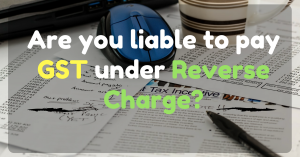 “Reverse Charge” means the liability to pay tax by the recipient of the supply of goods or services or both instead of the supplier of such goods or services or both. Normally, the supplier of goods or services pays the tax on supply. In the case of Reverse Charge, the receiver becomes liable to pay the tax, i.e., the chargeability gets reversed.
“Reverse Charge” means the liability to pay tax by the recipient of the supply of goods or services or both instead of the supplier of such goods or services or both. Normally, the supplier of goods or services pays the tax on supply. In the case of Reverse Charge, the receiver becomes liable to pay the tax, i.e., the chargeability gets reversed.
APPLICABILITY OF REVERSE CHARGE :
Unregistered dealer selling to a registered dealer - In such a case, the registered dealer has to pay GST on the supply.
Services through an e-commerce operator – An e-commerce operator is liable to pay the GST if the e-commerce supply is rendered by him. For example, Urban Clap provides services of plumbers, electricians, teachers, beauticians etc. Urban Clap is liable to pay GST and collect it from the customers instead of the registered service providers.
If the e-commerce operator does not have physical presence in the taxable territory, then a person representing such electronic commerce operator for any purpose will be liable to pay tax. If there is no representative, the operator will appoint a representative who will be held liable to pay GST.
Registration for Reverse Charge :
A person who is required to pay tax under reverse charge has to compulsorily register under GST and the threshold limit of Rs. 20 lakhs (Rs. 10 lakhs for special category states except J & K) is not applicable to him.
CBEC has explained the concept of Reverse Charge Mechanism under GST. Please refer cbec-explains-concept-of-reverse-charge-mechanism-under-gst.

 Toll Free:
Toll Free:  Contact Us
Contact Us

